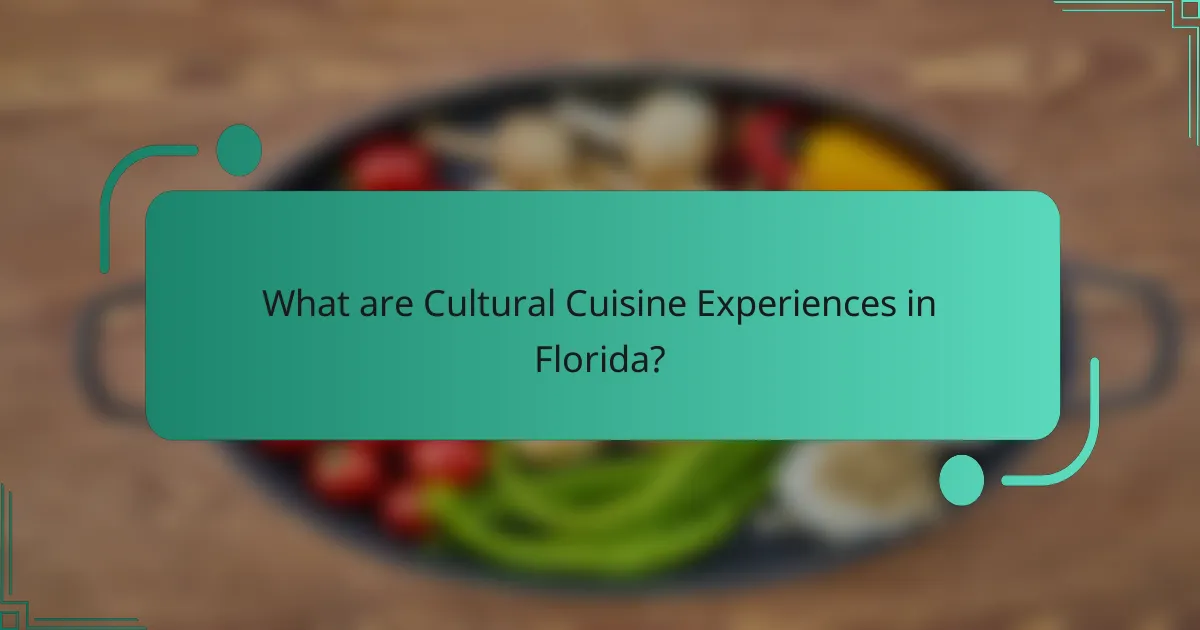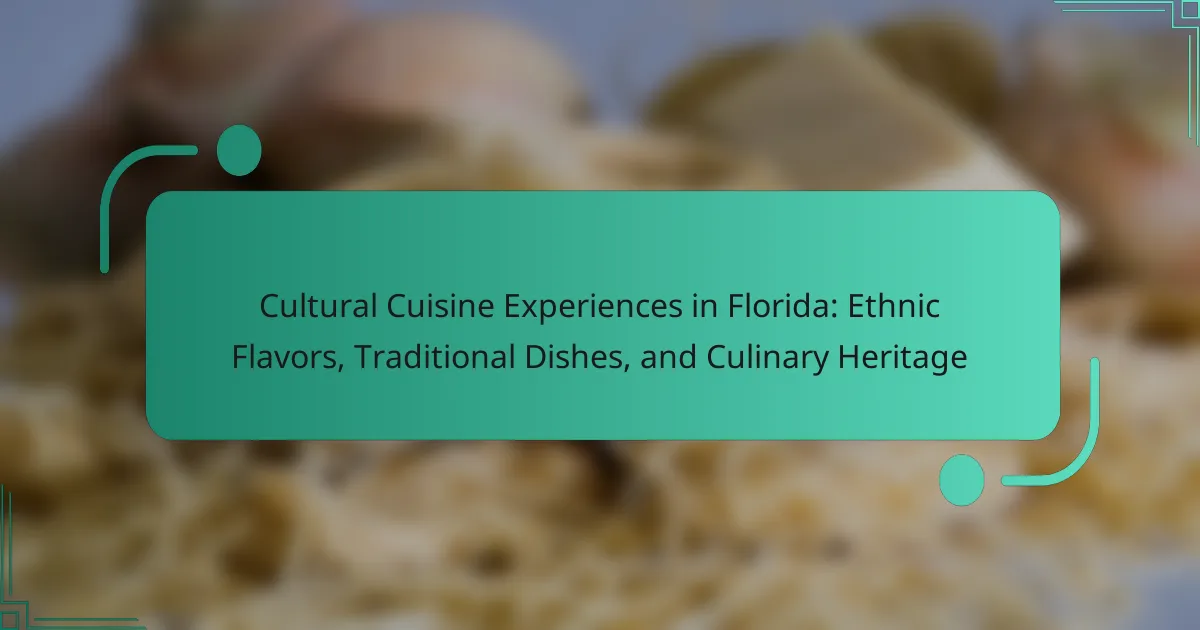Cultural cuisine experiences in Florida showcase the state’s diverse culinary traditions shaped by various ethnic communities. Key dishes include Cuban sandwiches, Haitian griot, and Italian pasta, reflecting influences from Latin American, Caribbean, African, and European cuisines. Florida hosts vibrant food festivals, such as the Calle Ocho Festival in Miami, celebrating these culinary heritages. Local restaurants often feature traditional recipes that highlight the state’s rich agricultural resources. Overall, Florida’s cultural cuisine experiences provide a unique gastronomic journey that emphasizes its multicultural heritage.

What are Cultural Cuisine Experiences in Florida?
Cultural cuisine experiences in Florida encompass diverse culinary traditions influenced by various ethnic communities. These experiences include tasting authentic dishes from Latin American, Caribbean, African, and European cuisines. Popular examples are Cuban sandwiches, Haitian griot, and Italian pasta dishes. Florida hosts numerous food festivals celebrating these cultural dishes, such as the Calle Ocho Festival in Miami. Additionally, local restaurants often showcase traditional recipes passed down through generations. The state’s rich agricultural resources also contribute to its vibrant culinary scene. Overall, Florida’s cultural cuisine experiences reflect its multicultural heritage and offer a unique gastronomic journey.
How do ethnic flavors shape Florida’s culinary landscape?
Ethnic flavors significantly shape Florida’s culinary landscape. The state’s diverse population contributes to a rich tapestry of culinary traditions. Cuban, Haitian, Jamaican, and Puerto Rican cuisines are particularly influential. These flavors are evident in popular dishes like Cuban sandwiches and jerk chicken. Florida’s agricultural bounty also enhances these cuisines with fresh, local ingredients. Food festivals celebrate this diversity, attracting both locals and tourists. This blending of cultures creates unique dining experiences across the state. Florida’s culinary identity is thus a vibrant reflection of its multicultural heritage.
What are the key ethnic groups contributing to Florida’s cuisine?
Key ethnic groups contributing to Florida’s cuisine include Hispanic, African American, and Caribbean communities. Hispanic influences come primarily from Cuban, Puerto Rican, and Mexican cultures. African American cuisine, particularly Southern and soul food traditions, plays a significant role in Florida’s culinary landscape. Caribbean flavors, especially from Haitian and Jamaican cultures, add unique spices and ingredients. These groups have shaped Florida’s food through traditional recipes and cooking methods. The diversity of these communities reflects the state’s rich cultural heritage. Their contributions create a vibrant culinary scene that attracts both locals and tourists.
How do regional ingredients influence these ethnic flavors?
Regional ingredients significantly influence ethnic flavors by providing unique tastes and textures. Each region has specific crops, spices, and proteins that shape its culinary identity. For example, Florida’s coastal areas contribute fresh seafood to dishes, enhancing their flavor profiles. Similarly, the availability of tropical fruits like mangoes and avocados adds sweetness and richness to local cuisines.
Cultural traditions also dictate how these ingredients are used, leading to distinct preparation methods. In Florida, the influence of Caribbean and Latin American cuisines is evident in the use of spices and cooking techniques. This results in vibrant dishes that reflect the local environment and heritage.
The diversity of regional ingredients creates a fusion of flavors, making ethnic dishes unique to Florida. Historical migration patterns have further enriched this culinary landscape, introducing new ingredients and cooking styles. This blend of local produce and cultural influences defines the ethnic flavors found in Florida’s culinary experiences.
What traditional dishes represent Florida’s cultural diversity?
Traditional dishes that represent Florida’s cultural diversity include Cuban sandwiches, stone crab claws, and Key lime pie. Cuban sandwiches reflect the influence of Cuban immigrants, featuring layers of roast pork, ham, Swiss cheese, pickles, and mustard on Cuban bread. Stone crab claws showcase Florida’s seafood heritage, harvested from the Gulf of Mexico and served with mustard sauce. Key lime pie, made from Key lime juice, sweetened condensed milk, and a graham cracker crust, represents the state’s citrus industry and is a popular dessert. These dishes highlight the blend of cultures that contribute to Florida’s unique culinary landscape.
Which dishes are considered staples in Florida’s cultural cuisine?
Staples in Florida’s cultural cuisine include key lime pie, stone crab, and Cuban sandwiches. Key lime pie is a famous dessert made from key lime juice, egg yolks, and sweetened condensed milk. It originated in the Florida Keys and is known for its tart flavor. Stone crab is a seafood delicacy harvested from the Gulf of Mexico. It is typically served with mustard sauce and is a seasonal dish. Cuban sandwiches reflect Florida’s rich Cuban heritage. They consist of Cuban bread filled with roasted pork, ham, Swiss cheese, pickles, and mustard. These dishes highlight the diverse culinary influences in Florida.
How do these dishes reflect the history and heritage of their cultures?
Dishes reflect the history and heritage of their cultures through their ingredients, preparation methods, and cultural significance. Traditional recipes often originate from historical events, migration patterns, and resource availability. For example, the use of local seafood in Floridian dishes showcases the region’s coastal heritage. Ingredients like spices and herbs reveal trade routes and cultural exchanges. Cooking techniques passed down through generations highlight the importance of family and community. Celebratory dishes often mark cultural festivals and rituals, reinforcing identity. Overall, these culinary practices serve as a narrative of cultural evolution and continuity.
Why is culinary heritage important in Florida?
Culinary heritage is important in Florida because it reflects the state’s diverse cultural history. Florida’s food traditions showcase influences from Native American, Spanish, African, and Caribbean cuisines. This blend creates unique dishes that represent the state’s identity. For instance, the use of local ingredients like citrus and seafood highlights Florida’s agricultural resources. Additionally, culinary heritage fosters community connections and preserves cultural practices. Festivals and events celebrating regional dishes promote tourism and local economies. Overall, Florida’s culinary heritage is a vital part of its cultural landscape, enriching the experience for residents and visitors alike.
How does culinary heritage contribute to community identity?
Culinary heritage significantly contributes to community identity by preserving traditional practices and flavors. It fosters a sense of belonging among community members. Shared meals and recipes create bonds and strengthen relationships. Culinary heritage reflects the history and cultural narratives of a community. For example, traditional dishes often tell stories of migration and adaptation. Celebrations centered around food reinforce cultural values and customs. Additionally, culinary events promote local pride and economic growth. Research shows that communities with strong culinary traditions exhibit higher levels of social cohesion.
What role does food play in cultural celebrations and festivals?
Food serves as a central element in cultural celebrations and festivals. It symbolizes heritage and community identity. Traditional dishes often reflect the history and values of a culture. For example, specific foods are prepared for holidays like Thanksgiving in the U.S. or Diwali in India. These meals are often shared among family and friends, fostering social bonds. Additionally, food rituals can include unique preparation methods or recipes passed down through generations. Festivals may also feature food as a means of honoring deities or ancestors. In Florida, diverse cultural communities showcase their culinary traditions during local festivals, enriching the state’s cultural landscape.
How can one experience Florida’s cultural cuisine?
To experience Florida’s cultural cuisine, one can explore diverse dining options across the state. Visiting local restaurants that specialize in regional dishes is essential. Sampling Cuban sandwiches in Miami showcases the influence of Cuban culture. Enjoying fresh seafood along the coast highlights Florida’s maritime heritage. Participating in food festivals allows for tasting various ethnic cuisines in one location. Engaging with local farmers’ markets provides access to fresh ingredients used in traditional recipes. Attending cooking classes can deepen understanding of Florida’s culinary techniques and heritage. Each of these activities connects individuals to the state’s rich cultural tapestry through food.
What are some popular restaurants that highlight ethnic flavors?
Versailles in Miami is renowned for its authentic Cuban cuisine. It serves traditional dishes like ropa vieja and lechon asado. Another popular spot is The Spice Route in Orlando, offering Indian flavors with dishes like butter chicken and biryani. In Tampa, Columbia Restaurant showcases Spanish cuisine, famous for its paella and tapas. Each of these restaurants highlights unique ethnic flavors, contributing to Florida’s diverse culinary scene.
What unique dining experiences can be found in these restaurants?
Unique dining experiences in these restaurants include immersive cultural themes and authentic ethnic cuisine. Many establishments feature live cooking demonstrations that showcase traditional preparation methods. Some restaurants offer multi-course tasting menus that highlight regional specialties. Interactive dining experiences, such as communal tables, encourage social interaction among guests. Certain venues provide music and dance performances that reflect the culture of the cuisine served. Seasonal festivals or special events often celebrate specific culinary traditions. Additionally, some restaurants incorporate local ingredients, enhancing the authenticity of the dishes. These experiences contribute to a deeper appreciation of Florida’s diverse culinary heritage.
What tips can enhance your cultural cuisine experience in Florida?
Explore local markets for authentic ingredients. Farmers’ markets in Florida offer fresh produce and spices. Attend cultural festivals that celebrate specific cuisines. Events like the Miami Spice Month highlight diverse food offerings. Try dining at family-owned restaurants for traditional recipes. These establishments often provide a genuine taste of cultural heritage. Participate in cooking classes to learn preparation techniques. Many local chefs offer classes focusing on ethnic dishes. Engage with local communities to discover hidden culinary gems. Networking can lead to unique dining experiences.
Cultural cuisine experiences in Florida represent a rich blend of ethnic flavors and traditional dishes influenced by diverse communities, including Hispanic, African American, and Caribbean populations. Key staples such as Cuban sandwiches, stone crab claws, and Key lime pie showcase the state’s unique culinary identity shaped by local ingredients and historical migration patterns. Food festivals and local restaurants play a vital role in celebrating this multicultural heritage, offering immersive dining experiences that highlight authentic recipes and cooking techniques. Overall, Florida’s culinary landscape reflects its vibrant cultural tapestry, fostering community connections and preserving culinary traditions.


